Understanding the Sustainable Hydrogen Generation Potential for the Region of Bavaria, Germany via Bio-Waste Processing Using Thermochemical Conversion Technology
Abstract
1. Introduction
- How will the availability and secure GE supply be ensured to generate sustainable fuels (SF) along with the direct primary applications of GE?
- How we will address the water availability for electrolysis applications, considering future possible water scarcity and increased SH demand?
- What is the impact of limited RE potential on SH generation in Bavaria?
2. Literature Review
2.1. Sustainable Hydrogen Production and Perceived Use Landscape
2.2. Bio-Waste Processing Landscape
2.3. Hydrogen Demand Landscape
2.4. Overview of Possible Suitable Thermochemical Conversion Technologies
2.5. Identification of Research Gap
3. Bavaria Region
- Spatial expansion of capacity (such as the expansion of the electrical grid);
- Temporal expansion of the capacity (employing energy storage options);
- Improved flexibility (by providing gas as well as hydrogen-based power generation options).
4. Materials and Methods
4.1. Input Materials Considered
- Recycling;
- Thermal disposal;
- Other methods of direct disposal.
4.2. Assessing Organic Waste (Domestic BW and SS) Generation Landscape for the Bavarian Region
4.3. Accessing TCR Potential for SH Production
- H2 fraction in volume percentage;
- Other gases in volume percentage.
4.4. Scenario Creation
- Baseline (27% gas output from TCR process with 55% H2 fraction in it);
- Optimistic (44% gas output from TCR process with 55% H2 fraction in it).
- BW only (Baseline);
- SS only (Baseline);
- BW+SS (Baseline);
- BW only (Optimistic);
- SS only (Optimistic);
- BW+SS (Optimistic).
- 1 kg of H2 = 33.3 kWh equivalent of H2;
- 1 TWh equivalent H2 = 30.030 × 103 Mt of H2.
5. Results
5.1. Industry
5.2. Transportation
5.3. Conversion
5.4. Buildings
6. Discussion
- Based on input materials and scenarios;
- Based on sectors and years under consideration.
Cost Landscape
7. Conclusions
8. Future Work
Funding
Data Availability Statement
Acknowledgments
Conflicts of Interest
References
- IEA. World Energy Outlook; IEA: Paris, France, 2021. [Google Scholar]
- Commission of the European Communities. Communication from the Commission to the European Parliament, the Council, the European Economic and Social Committee and the Committee of the Regions; European Commission: Brussels, Belgium, 2011. [Google Scholar]
- Goers, S.; Rumohr, F.; Fendt, S.; Gosselin, L.; Jannuzzi, G.M.; Gomes, R.D.; Sousa, S.M.; Wolvers, R. The role of renewable energy in regional energy transitions: An aggregate qualitative analysis for the partner regions Bavaria, Georgia, Québec, São Paulo, Shandong, Upper Austria, and Western Cape. Sustainability 2020, 13, 76. [Google Scholar] [CrossRef]
- Juhrich, K. CO2 Emission Factors for Fossil Fuels; German Environment Agency: Copenhagen, Denmark, 2016. [Google Scholar]
- Full, J.; Trauner, M.; Miehe, R.; Sauer, A. Carbon-negative hydrogen production (HyBECCS) from organic waste materials in Germany: How to estimate bioenergy and greenhouse gas mitigation potential. Energies 2021, 14, 7741. [Google Scholar] [CrossRef]
- Badea, N.I. Hydrogen as energy sources—Basic concepts. Energies 2021, 14, 5783. [Google Scholar] [CrossRef]
- Jaradat, M.; Almashaileh, S.; Bendea, C.; Juaidi, A.; Bendea, G.; Bungau, T. Green hydrogen in focus: A review of production technologies, policy impact, and market developments. Energies 2024, 17, 3992. [Google Scholar] [CrossRef]
- Noyan, O.F.; Hasan, M.M.; Pala, N. A global review of the hydrogen energy eco-system. Energies 2023, 16, 1484. [Google Scholar] [CrossRef]
- BMUV. Waste Management in Germany 2023; Technical Report; Federal Ministry for the Environment, Nature Conservation, Nuclear Safety and Consumer Protection (BMUV): Berlin, Germany, 2023. [Google Scholar]
- Ouadi, M.; Jaeger, N.; Greenhalf, C.; Santos, J.; Conti, R.; Hornung, A. Thermo-Catalytic Reforming of municipal solid waste. Waste Manag. 2017, 68, 198–206. [Google Scholar] [CrossRef]
- Bhandari, R.; Shah, R.R. Hydrogen as energy carrier: Techno-economic assessment of decentralized hydrogen production in Germany. Renew. Energy 2021, 177, 915–931. [Google Scholar] [CrossRef]
- Grunow, P. Decentral Hydrogen. Energies 2022, 15, 2820. [Google Scholar] [CrossRef]
- Welder, L.; Ryberg, D.S.; Kotzur, L.; Grube, T.; Robinius, M.; Stolten, D. Spatio-temporal optimization of a future energy system for power-to-hydrogen applications in Germany. Energy 2018, 158, 1130–1149. [Google Scholar] [CrossRef]
- Michalski, J.; Bünger, U.; Crotogino, F.; Donadei, S.; Schneider, G.S.; Pregger, T.; Cao, K.K.; Heide, D. Hydrogen generation by electrolysis and storage in salt caverns: Potentials, economics and systems aspects with regard to the German energy transition. Int. J. Hydrog. Energy 2017, 42, 13427–13443. [Google Scholar] [CrossRef]
- Kendziorski, M.; Göke, L.; von Hirschhausen, C.; Kemfert, C.; Zozmann, E. Centralized and decentral approaches to succeed the 100% energiewende in Germany in the European context—A model-based analysis of generation, network, and storage investments. Energy Policy 2022, 167, 113039. [Google Scholar] [CrossRef]
- Kalchschmid, V.; Erhart, V.; Angerer, K.; Roth, S.; Hohmann, A. Decentral Production of Green Hydrogen for Energy Systems: An Economically and Environmentally Viable Solution for Surplus Self-Generated Energy in Manufacturing Companies? Sustainability 2023, 15, 2994. [Google Scholar] [CrossRef]
- Murray, P.; Orehounig, K.; Grosspietsch, D.; Carmeliet, J. A comparison of storage systems in neighbourhood decentralized energy system applications from 2015 to 2050. Appl. Energy 2018, 231, 1285–1306. [Google Scholar] [CrossRef]
- Lahnaoui, A.; Wulf, C.; Dalmazzone, D. Optimization of hydrogen cost and transport technology in France and Germany for various production and demand scenarios. Energies 2021, 14, 744. [Google Scholar] [CrossRef]
- Franzmann, D.; Heinrichs, H.; Lippkau, F.; Addanki, T.; Winkler, C.; Buchenberg, P.; Hamacher, T.; Blesl, M.; Linßen, J.; Stolten, D. Green hydrogen cost-potentials for global trade. Int. J. Hydrogen Energy 2023, 48, 33062–33076. [Google Scholar] [CrossRef]
- Dietz, W.; Reinelt, B.; Thiel, N.; Schönemann, M.; Seitz, M.; Rommel, W. Potenziale einer Wasserstoffgewinnung durch Vergasung von Gewerbeabfall; Technical Report; bifa Umweltinstitut: Augsburg, Germany, 2022. [Google Scholar]
- Hasan, M.H.; Mahlia, T.M.I.; Mofijur, M.; Rizwanul Fattah, I.; Handayani, F.; Ong, H.C.; Silitonga, A. A Comprehensive Review on the Recent Development of Ammonia as a Renewable Energy Carrier. Energies 2021, 14, 3732. [Google Scholar] [CrossRef]
- Negro, V.; Noussan, M.; Chiaramonti, D. The potential role of ammonia for hydrogen storage and transport: A critical review of challenges and opportunities. Energies 2023, 16, 6192. [Google Scholar] [CrossRef]
- Asif, M.; Bibi, S.S.; Ahmed, S.; Irshad, M.; Hussain, M.S.; Zeb, H.; Khan, M.K.; Kim, J. Recent advances in green hydrogen production, storage and commercial-scale use via catalytic ammonia cracking. Chem. Eng. J. 2023, 473, 145381. [Google Scholar] [CrossRef]
- Yousefi Rizi, H.A.; Shin, D. Green hydrogen production technologies from ammonia cracking. Energies 2022, 15, 8246. [Google Scholar] [CrossRef]
- Moreno, V.C.; Iervolino, G.; Tugnoli, A.; Cozzani, V. Techno-economic and environmental sustainability of biomass waste conversion based on thermocatalytic reforming. Waste Manag. 2020, 101, 106–115. [Google Scholar] [CrossRef]
- Naegeli de Torres, F.; Brödner, R.; Cyffka, K.-F.; Fais, A.; Kalcher, J.; Kazmin, S.; Meyer, R.; Radke, K.-S.; Richter, F.; Selig, M.; et al. DBFZ Resource Database: DE-Biomass Monitor. Biomass Potentials and Utilization of Biogenic Wastes and Residues in Germany 2010–2020. Zenodo 2023. [Google Scholar] [CrossRef]
- Klein, D.; Wolf, C.; Schulz, C.; Weber-Blaschke, G. Environmental impacts of various biomass supply chains for the provision of raw wood in Bavaria, Germany, with focus on climate change. Sci. Total. Environ. 2016, 539, 45–60. [Google Scholar] [CrossRef] [PubMed]
- Siwal, S.S.; Sheoran, K.; Saini, A.K.; Vo, D.V.N.; Wang, Q.; Thakur, V.K. Advanced thermochemical conversion technologies used for energy generation: Advancement and prospects. Fuel 2022, 321, 124107. [Google Scholar] [CrossRef]
- Auer, K.; Rogers, H. A research agenda for circular food waste management in Bavaria. Transp. Res. Procedia 2022, 67, 131–136. [Google Scholar] [CrossRef]
- Rada, E.C.; Istrate, I.A.; Ragazzi, M. Trends in the management of residual municipal solid waste. Environ. Technol. 2009, 30, 651–661. [Google Scholar] [CrossRef]
- Zaman, A.U. Life cycle environmental assessment of municipal solid waste to energy technologies. Glob. J. Environ. Res. 2009, 3, 155–163. [Google Scholar]
- Ateş, F.; Miskolczi, N.; Borsodi, N. Comparision of real waste (MSW and MPW) pyrolysis in batch reactor over different catalysts. Part I: Product yields, gas and pyrolysis oil properties. Bioresour. Technol. 2013, 133, 443–454. [Google Scholar] [CrossRef]
- Chen, D.; Yin, L.; Wang, H.; He, P. Pyrolysis technologies for municipal solid waste: A review. Waste Manag. 2014, 34, 2466–2486. [Google Scholar] [CrossRef]
- Wietschel, M.; Zheng, L.; Arens, M.; Hebling, C.; Ranzmeyer, O.; Schaadt, A.; Hank, C.; Sternberg, A.; Herkel, S.; Kost, C.; et al. Metastudie Wasserstoff-Auswertung von Energiesystemstudien; Anschrift und Besucheradresse: Freiburg, Germany, 2021. [Google Scholar]
- Wettengel, J. Germany’s Future Hydrogen Needs Significantly Higher than Expected; Technical Report; Clean Energy Wire: Berlin, Germany, 2021. [Google Scholar]
- Scharf, H.; Sauerbrey, O.; Möst, D. What will be the hydrogen and power demands of the process industry in a climate-neutral Germany? J. Clean. Prod. 2024, 466, 142354. [Google Scholar] [CrossRef]
- Riemer, M.; Zheng, L.; Eckstein, J.; Wietschel, M.; Pieton, N.; Kunze, R. Future Hydrogen Demand: A Cross-Sectoral, Global Meta-Analysis; Fraunhofer ISI Karlsruhe: Munich, Germany, 2022. [Google Scholar]
- Wappler, M.; Unguder, D.; Lu, X.; Ohlmeyer, H.; Teschke, H.; Lueke, W. Building the green hydrogen market–Current state and outlook on green hydrogen demand and electrolyzer manufacturing. Int. J. Hydrogen Energy 2022, 47, 33551–33570. [Google Scholar] [CrossRef]
- Scheller, F.; Wald, S.; Kondziella, H.; Gunkel, P.A.; Bruckner, T.; Keles, D. Future role and economic benefits of hydrogen and synthetic energy carriers in Germany: A review of long-term energy scenarios. Sustain. Energy Technol. Assess. 2023, 56, 103037. [Google Scholar] [CrossRef]
- IRENA. Global Energy Transformation: A Roadmap to 2050; Technical Report; IRENA; International Renewable Energy Agency: Abu Dhabi, United Arab Emirates, 2019. [Google Scholar]
- Council, H.; Company, M. Hydrogen for Net-Zero A Critical Cost-Competitive Energy Vector; Technical Report; Hydrogen Council, McKinsey & Company: Brussels, Belgium, 2021. [Google Scholar]
- Philipp Runge, S.D. Hydrogen Roadmap Bavaria Perspectives and Recommendations Towards the Ramp-Up of the Bavarian Hydrogen Economy; Technical Report; Hydrogen Center Bavaria: Nuremberg, Germany, 2022. [Google Scholar]
- Bique, A.O.; Zondervan, E. An outlook towards hydrogen supply chain networks in 2050—Design of novel fuel infrastructures in Germany. Chem. Eng. Res. Des. 2018, 134, 90–103. [Google Scholar] [CrossRef]
- München, S. Stadtwerke München; Verlag Nicht Ermittelbar: Freiburg im Breisgau, Germany, 1997. [Google Scholar]
- Lee, J.; Hong, S.; Cho, H.; Lyu, B.; Kim, M.; Kim, J.; Moon, I. Machine learning-based energy optimization for on-site SMR hydrogen production. Energy Convers. Manag. 2021, 244, 114438. [Google Scholar] [CrossRef]
- Kargbo, H.O.; Zhang, J.; Phan, A.N. Optimisation of two-stage biomass gasification for hydrogen production via artificial neural network. Appl. Energy 2021, 302, 117567. [Google Scholar] [CrossRef]
- Bayerisches Landesamt für Statistik 2024. Available online: https://www.statistik.bayern.de/ (accessed on 12 December 2024).
- National Bioeconomy Strategy, German Federal Ministry of Food and Agriculture. July 2020. Available online: https://www.bmel.de/EN/Home/home_node.html (accessed on 12 December 2024).
- Günther, S.; Karras, T.; Naegeli de Torres, F.; Semella, S.; Thrän, D. Temporal and spatial mapping of theoretical biomass potential across the European Union. Earth Syst. Sci. Data 2023, 16, 59–74. [Google Scholar] [CrossRef]
- Schmitt, N.; Apfelbacher, A.; Jäger, N.; Daschner, R.; Stenzel, F.; Hornung, A. Thermo-chemical conversion of biomass and upgrading to biofuel: The Thermo-Catalytic Reforming process—A review. Biofuels Bioprod. Biorefining 2019, 13, 822–837. [Google Scholar] [CrossRef]
- Conti, R.; Jäger, N.; Neumann, J.; Apfelbacher, A.; Daschner, R.; Hornung, A. Thermocatalytic reforming of biomass waste streams. Energy Technol. 2017, 5, 104–110. [Google Scholar] [CrossRef]
- Schmidt, M.; Singh, B. Selectively closing recycling centers in Bavaria: Reforming waste-management policy to reduce disparity. Networks 2024, 84, 148–160. [Google Scholar] [CrossRef]
- Hornung, A.; Jahangiri, H.; Ouadi, M.; Kick, C.; Deinert, L.; Meyer, B.; Grunwald, J.; Daschner, R.; Apfelbacher, A.; Meiller, M.; et al. Thermo-Catalytic Reforming (TCR)—An important link between waste management and renewable fuels as part of the energy transition. Appl. Energy Combust. Sci. 2022, 12, 100088. [Google Scholar] [CrossRef]
- Mahmood, A.S.; Brammer, J.G.; Hornung, A.; Steele, A.; Poulston, S. The intermediate pyrolysis and catalytic steam reforming of Brewers spent grain. J. Anal. Appl. Pyrolysis 2013, 103, 328–342. [Google Scholar] [CrossRef]
- Klaas, M.; Greenhalf, C.; Ouadi, M.; Jahangiri, H.; Hornung, A.; Briens, C.; Berruti, F. The effect of torrefaction pre-treatment on the pyrolysis of corn cobs. Results Eng. 2020, 7, 100165. [Google Scholar] [CrossRef]
- Neumann, J.; Meyer, J.; Ouadi, M.; Apfelbacher, A.; Binder, S.; Hornung, A. The conversion of anaerobic digestion waste into biofuels via a novel Thermo-Catalytic Reforming process. Waste Manag. 2016, 47, 141–148. [Google Scholar] [CrossRef] [PubMed]
- Whalen, C. Some Rules of Thumb of the Hydrogen Economy. Online Blog Post. June 2021. Available online: https://www.carboncommentary.com/blog/2021/6/11/some-rules-of-thumb-of-the-hydrogen-economy (accessed on 12 December 2024).
- Jensterle, M.; Narita, J.; Piria, R.; Samadi, S.; Prantner, M.; Crone, K.; Siegemund, S.; Kan, S.; Matsumoto, T.; Shibata, Y.; et al. The Role of Clean Hydrogen in the Future Energy Systems of Japan and Germany: An Analysis of Existing Mid-Century Scenarios and an Investigation of Hydrogen Supply Chains; Technical Report; Wuppertal Institut: Wuppertal, Germany, 2019. [Google Scholar]
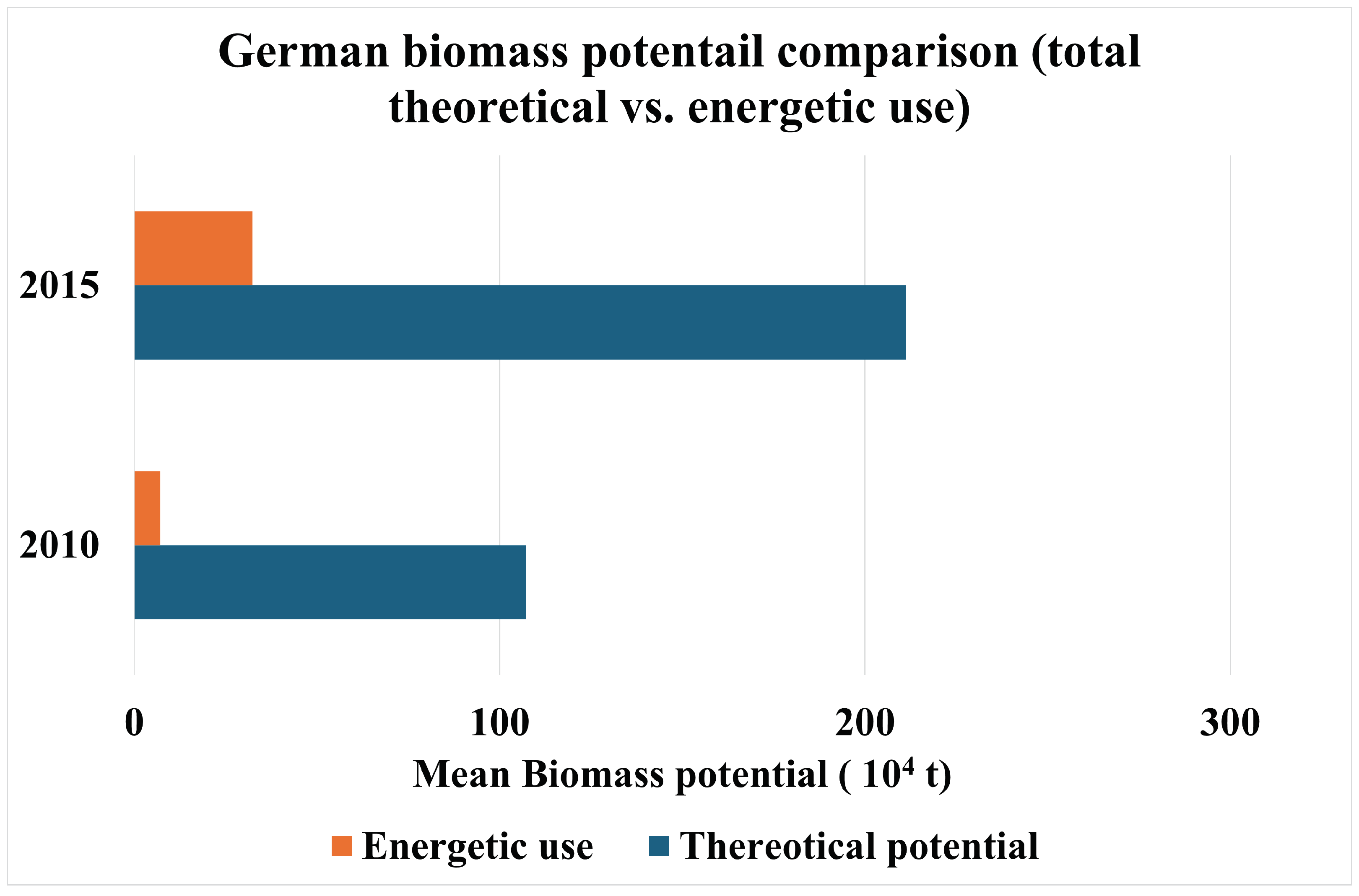
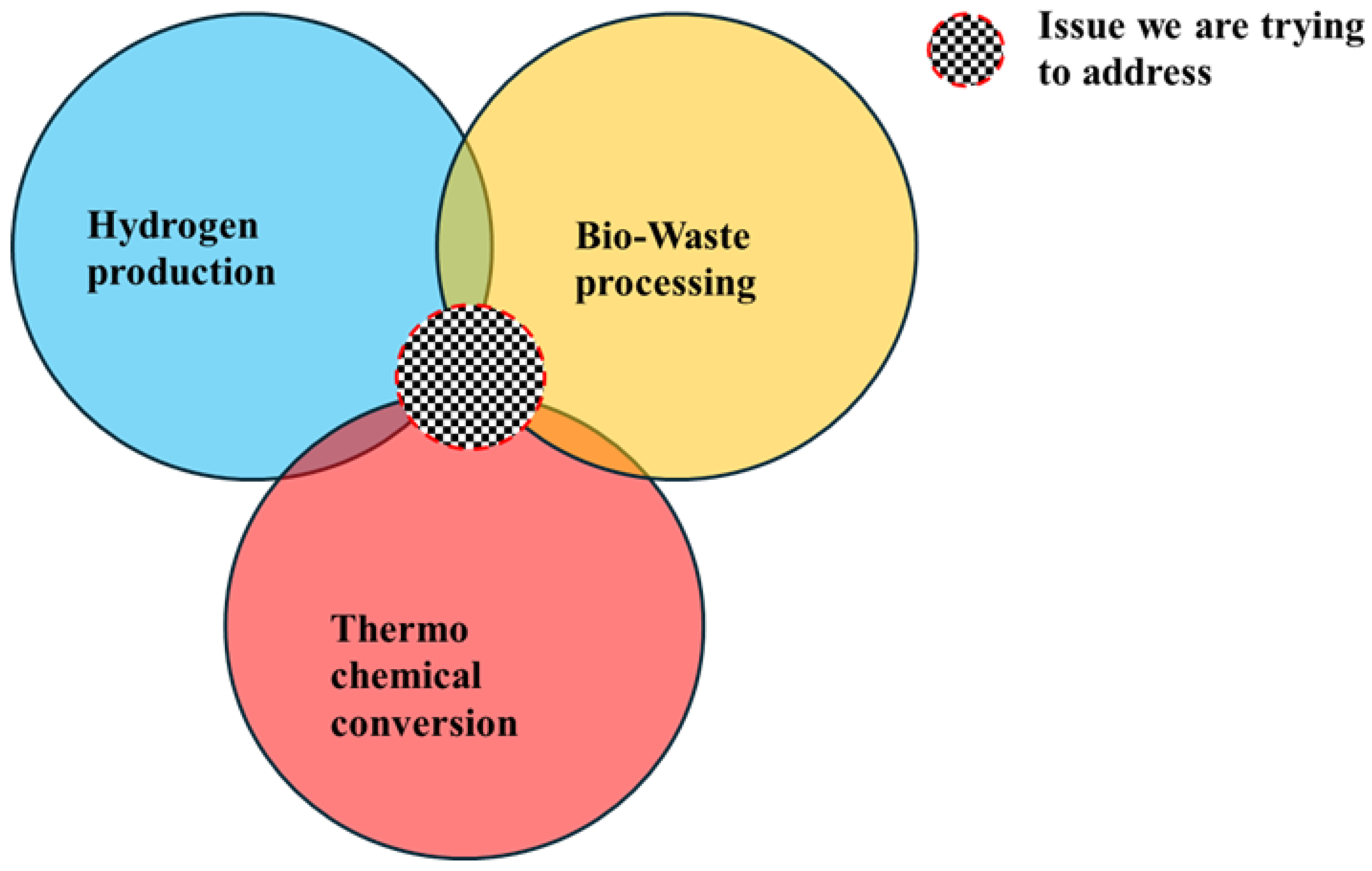
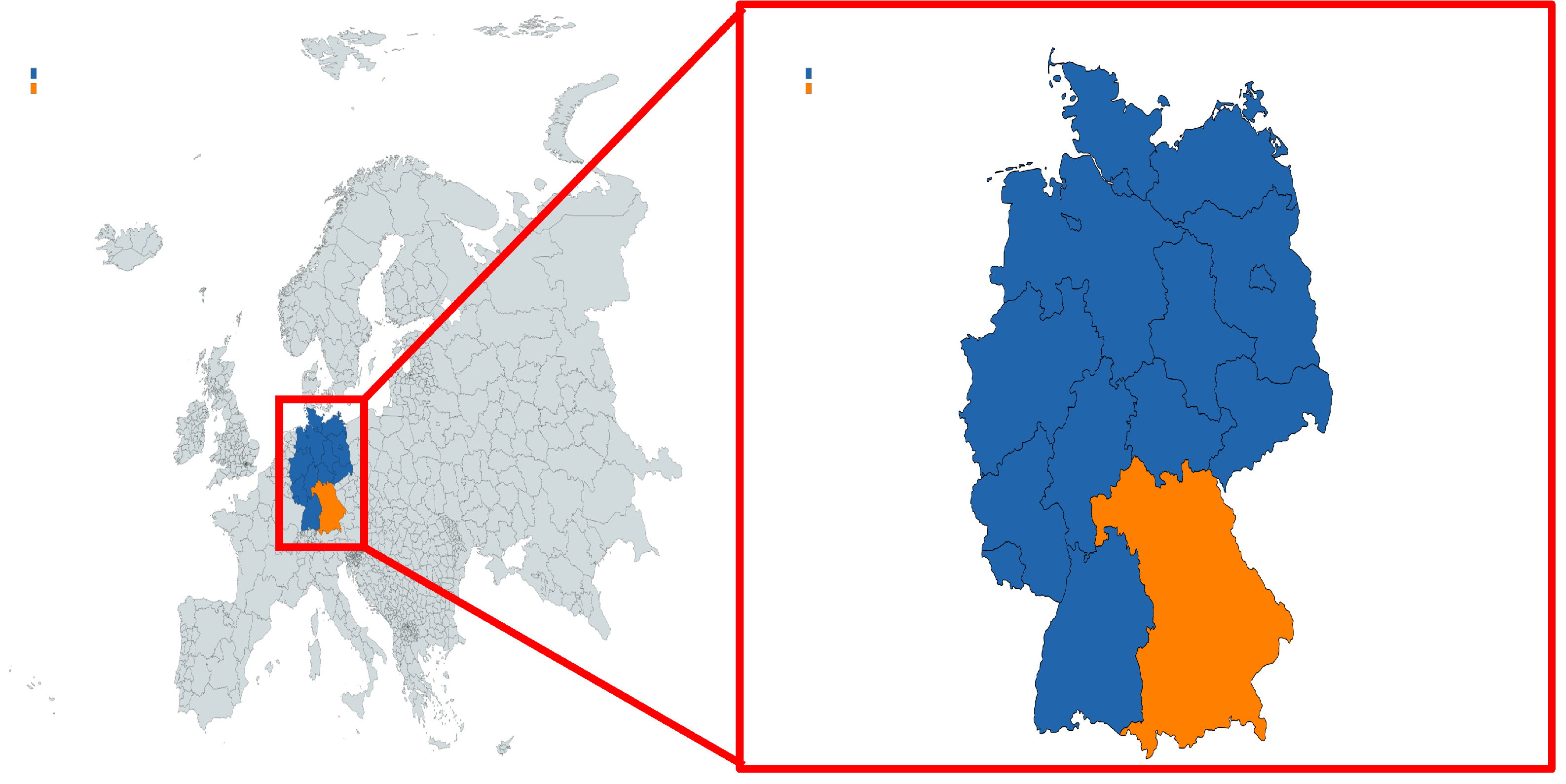




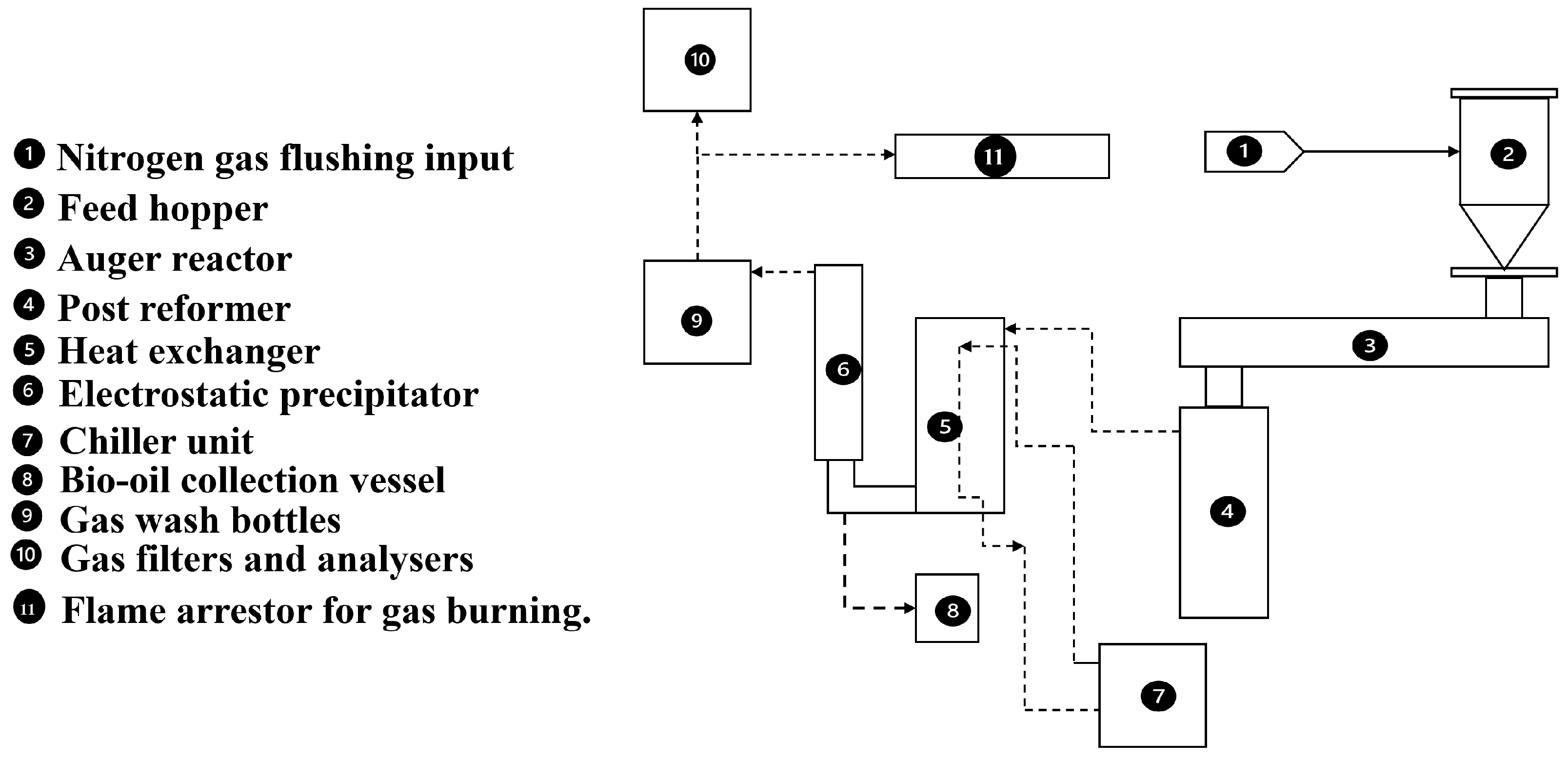
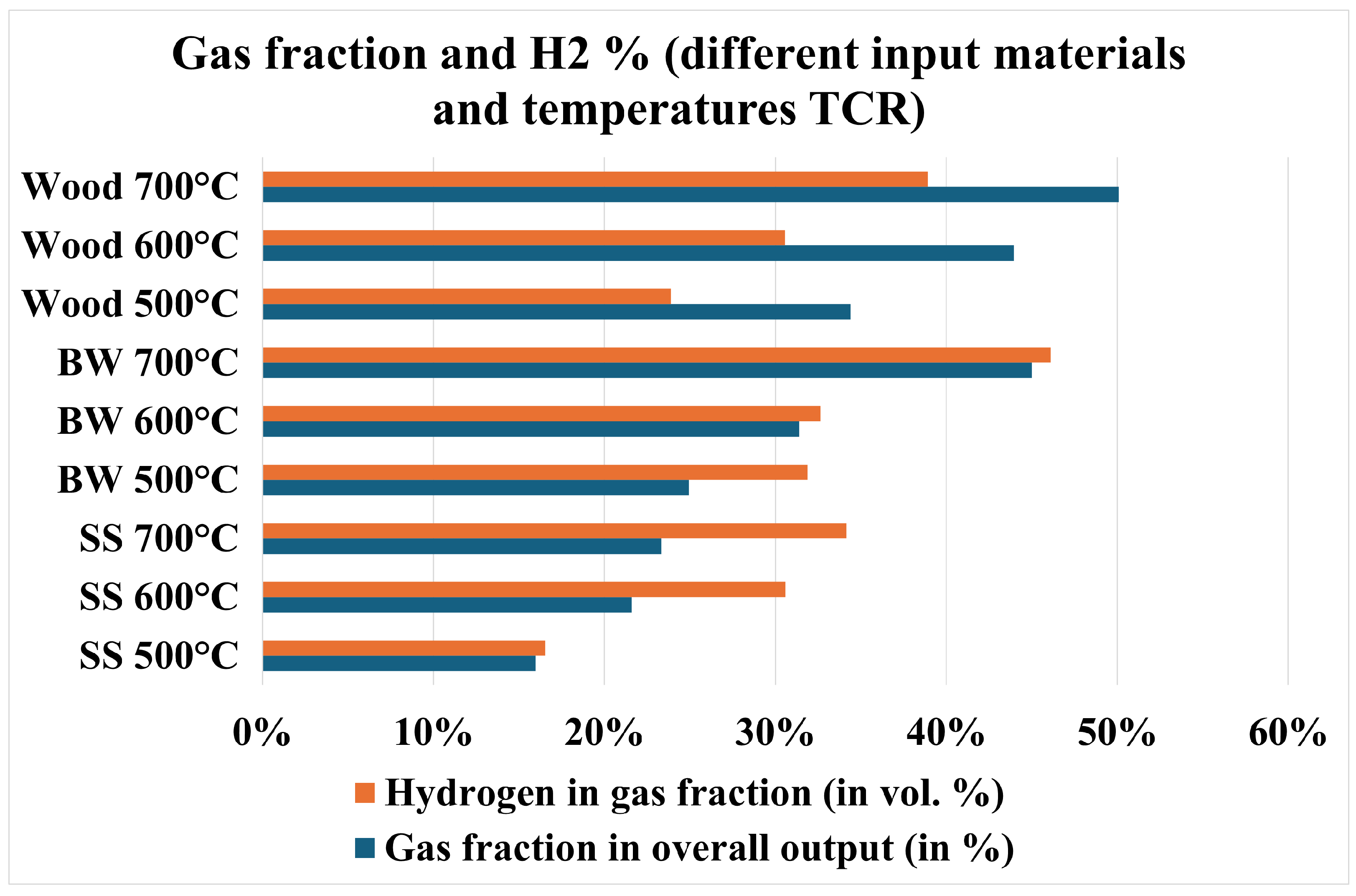
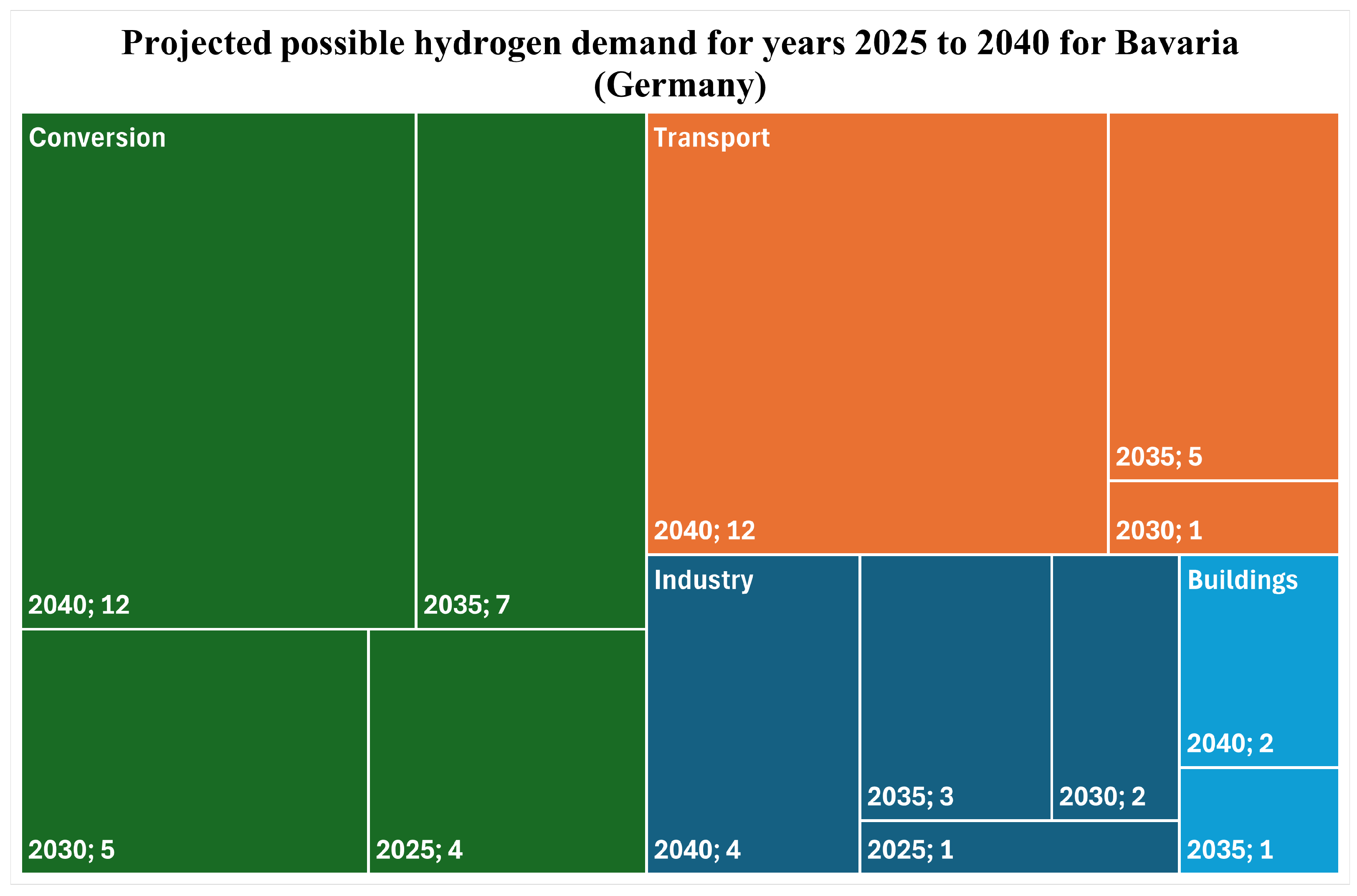
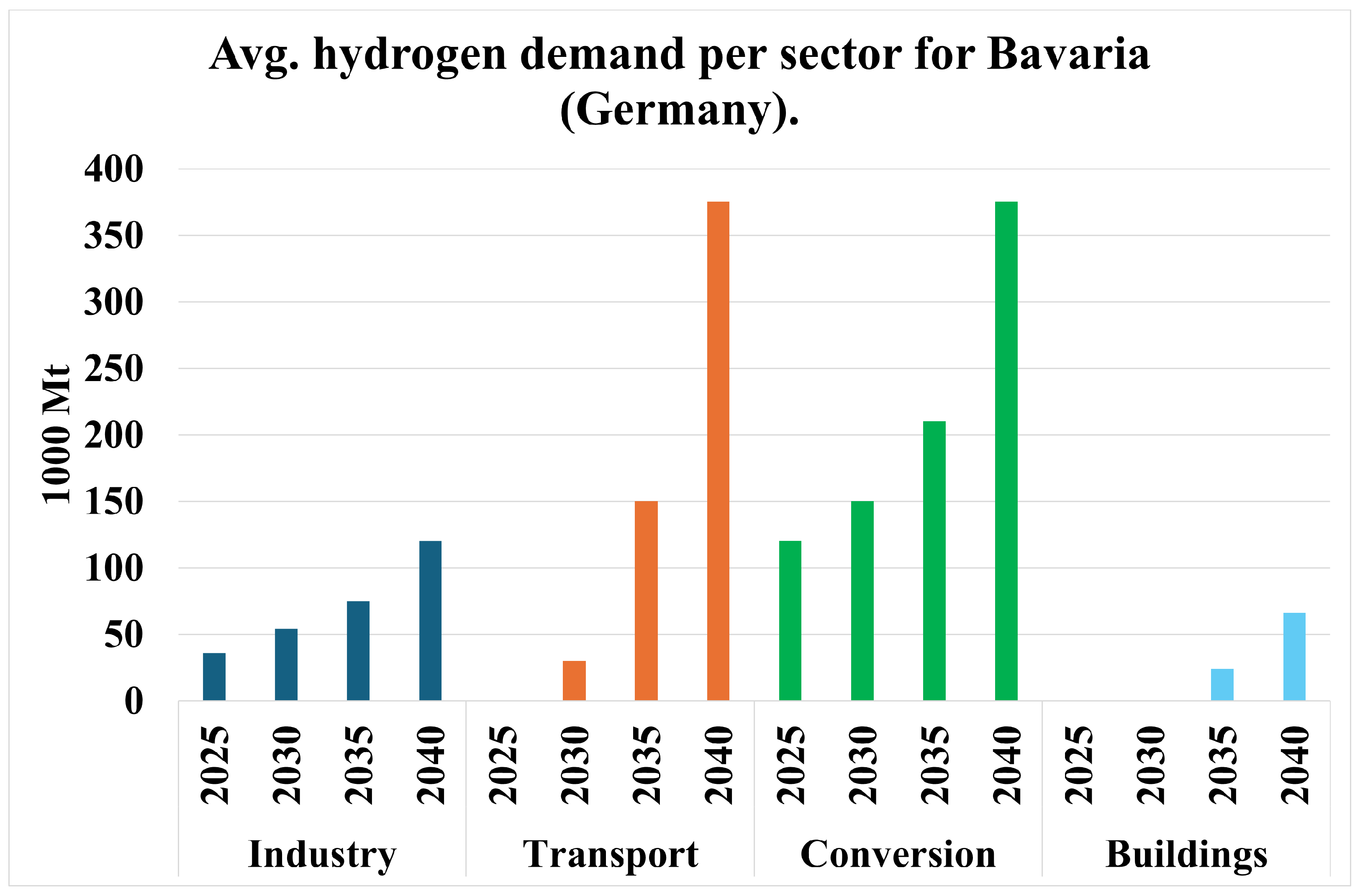


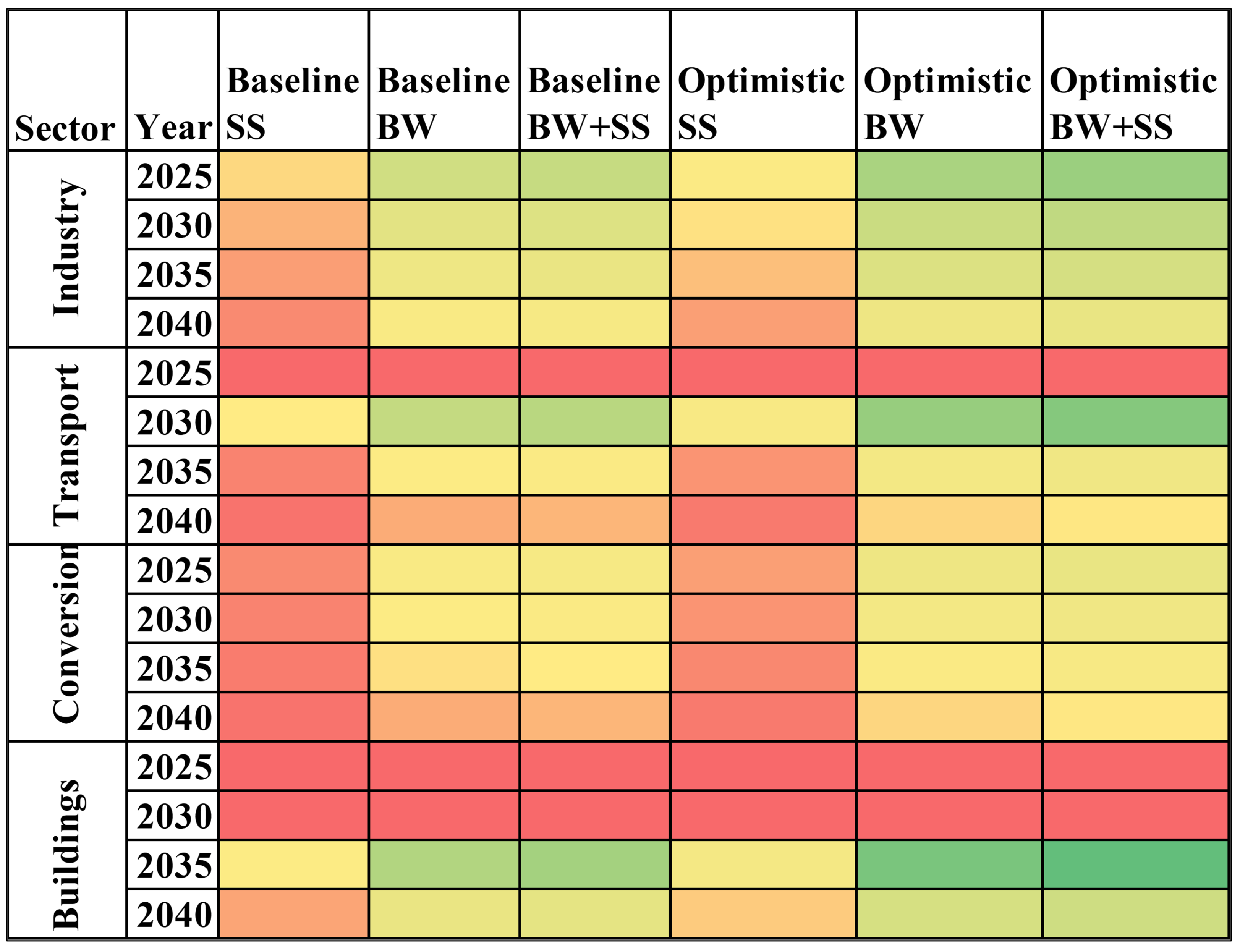
| Colour Scheme and Classification (Hydrogen) | ||
|---|---|---|
| Source | Method | Colour |
| Black coal | Gasification | Black |
| Lignite (Brown coal) | Gasification | Brown |
| Natural Gas | Natural gas reforming | Gray |
| Oil | Partial oxidation | Gray |
| Byproduct | Naphtha reformation | Gray |
| Byproduct | Chlor-alkali electrolysis | Gray |
| Natural Gas + CCS | Natural gas reforming | Blue |
| Methane | Pyrolysis | Turquoise |
| Nuclear Energy | Water electrolysis | Pink |
| Mixed Grid Electricity | Water electrolysis | Yellow |
| Renewable Energy | Water electrolysis | Green |
| Feedstock Composition | |||
|---|---|---|---|
| Ultimate Analysis a | Unit | MSW (BW) | SS |
| C | wt% | 43.1 | 23.3 |
| H | wt% | 6.1 | 4.3 |
| N | wt% | 1.0 | 3.6 |
| S | wt% | 0.3 | 0.9 |
| O b | wt% | 31.4 | 19.7 |
| Proximate Analysis c | |||
| Moisture | wt% | 10.0 | 9.7 |
| Ash | wt% | 18.1 | 46.5 |
| HHV | MJ·kg−1 | 18.3 | 10.0 |
| Total Organic Waste (in 1000 t) | |
|---|---|
| BW | 1768.881 |
| SS | 281.70 |
| Total avg. | 2050.59 |
Disclaimer/Publisher’s Note: The statements, opinions and data contained in all publications are solely those of the individual author(s) and contributor(s) and not of MDPI and/or the editor(s). MDPI and/or the editor(s) disclaim responsibility for any injury to people or property resulting from any ideas, methods, instructions or products referred to in the content. |
© 2025 by the author. Licensee MDPI, Basel, Switzerland. This article is an open access article distributed under the terms and conditions of the Creative Commons Attribution (CC BY) license (https://creativecommons.org/licenses/by/4.0/).
Share and Cite
Prabhu, S.D. Understanding the Sustainable Hydrogen Generation Potential for the Region of Bavaria, Germany via Bio-Waste Processing Using Thermochemical Conversion Technology. Energies 2025, 18, 2002. https://doi.org/10.3390/en18082002
Prabhu SD. Understanding the Sustainable Hydrogen Generation Potential for the Region of Bavaria, Germany via Bio-Waste Processing Using Thermochemical Conversion Technology. Energies. 2025; 18(8):2002. https://doi.org/10.3390/en18082002
Chicago/Turabian StylePrabhu, Shashank Deepak. 2025. "Understanding the Sustainable Hydrogen Generation Potential for the Region of Bavaria, Germany via Bio-Waste Processing Using Thermochemical Conversion Technology" Energies 18, no. 8: 2002. https://doi.org/10.3390/en18082002
APA StylePrabhu, S. D. (2025). Understanding the Sustainable Hydrogen Generation Potential for the Region of Bavaria, Germany via Bio-Waste Processing Using Thermochemical Conversion Technology. Energies, 18(8), 2002. https://doi.org/10.3390/en18082002







